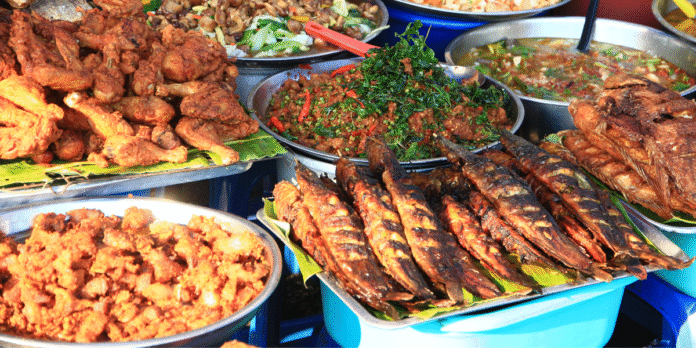Kamorta turned into a vibrant hub of culture, food, and community enterprise on August 15 and 16 as the Block Mela-cum-Tribal Food Festival unfolded at the Hockey Ground, Nancowry. Organised under the flagship programme of the Government of India, Deendayal Antyodaya Yojana – National Rural Livelihood Mission (DAY-NRLM), the two-day event combined cultural expression with entrepreneurship, attracting villagers, officials, and self-help groups (SHGs) from across the Nicobar district.
The festival was inaugurated by Assistant Commissioner of Nancowry, Aditya Sangotra, who served as chief guest, accompanied by Chief Tribal Captain Ayesha Majeed, Tribal Captain Charles Jacob, Block Development Officer Mohammed Yunus, and other department heads. Their presence reflected the strong emphasis on inter-departmental collaboration that has become essential in organising such multi-faceted programmes. In his inaugural remarks, the Assistant Commissioner stressed the importance of cooperation among departments, noting that when institutions work together, the delivery of services improves and citizens gain greater awareness of welfare initiatives.
The event was structured around three broad themes: livelihood promotion, cultural preservation, and social cohesion. From the outset, it drew significant participation, with more than 150 SHG members representing villages from Katchal, Teressa, Bunderkhadi, and other remote areas. The festival gave them a platform to display handicrafts, embroidery, agricultural produce, and processed foods, creating opportunities for both sales and exposure. For participants, many of whom operate in remote and limited markets, the mela was both an economic opportunity and a confidence-building exercise.
One of the highlights of the festival was the launch of NiCoShe, a brand of virgin coconut oil created and marketed by Manula Mathai Payuh, a producer group formed under DAY-NRLM. The product drew attention not only as an example of value addition to a traditional resource but also as a case study of how self-help groups can scale up into marketable enterprises. Virgin coconut oil, long associated with health benefits and cosmetic uses, has significant potential, and the branding of NiCoShe was seen as an important step towards giving local products a distinctive identity.
Another innovative feature was the introduction of a Virtual Reality show, organised in collaboration with the Department of Information, Publicity and Tourism. For the first time in Nancowry, residents could experience immersive three-dimensional views of tribal villages such as Daring, Munak, and Hodi Race, along with natural sites like Kamorta Harbour. The initiative not only added an entertainment element but also hinted at the possibilities of technology in promoting cultural tourism in the islands.
Cultural performances remained at the heart of the festival. The much-anticipated “Dance Nancowry Dance” competition brought together youth from different islands and villages, who competed in both traditional and contemporary dance forms. The energy of the performances, blending heritage with modern creativity, captured the festival spirit and ensured enthusiastic participation from audiences. Tribal food stalls, meanwhile, showcased the rich culinary diversity of the Nicobarese community. Dishes prepared from coconut, pandanus, yam, taro, and freshly caught seafood reflected age-old traditions that continue to define the island diet. For visitors, the food festival was as much an educational journey as a sensory experience, bringing rare dishes to the fore.
The festival also revived the spirit of traditional games and competitions. Events like tug of war, coconut grating, arm wrestling, and pass-the-ball attracted participants across age groups, rekindling community bonds that often find expression during local gatherings. For many, these competitions evoked nostalgia, recalling times when such games were integral to village festivals.
The involvement of multiple government departments gave the mela a broader scope. Units like Animal Husbandry, Agriculture, Fisheries, Fire Services, Health, Rural Development, Social Welfare, and even the State Bank of India set up stalls and information counters to explain schemes and services. Representatives interacted with villagers, answering questions and distributing pamphlets. INS Kardip also participated, reinforcing the integration of defence services into community engagement. By placing government officials and citizens in direct contact, the mela bridged gaps that often exist between administration and grassroots.
The Tribal Food Festival segment proved especially popular. Self-help groups competed to present traditional delicacies, while villagers and guests sampled the offerings. The initiative not only highlighted culinary diversity but also provided economic opportunities for women-led groups who form the backbone of the SHG network. By giving them visibility and recognition, the festival aligned with the DAY-NRLM objective of grassroots empowerment.
For the local administration, the event was as much about fostering unity as it was about cultural display. By creating a platform where traditional leaders, government officials, and villagers could interact, the mela reinforced social cohesion. The format of combining food, culture, entrepreneurship, and recreation ensured that it appealed to all sections of the community.
The response from villagers underscored the importance of such initiatives. For many participants, travelling from remote islands to Kamorta involved significant effort. Yet, the willingness to participate and showcase their skills highlighted the value communities place on opportunities to connect, learn, and grow.
As the festival concluded, the Hockey Ground retained the echoes of dance performances, laughter from games, and the aroma of traditional food. The event not only celebrated tribal heritage but also demonstrated how modern frameworks like DAY-NRLM can empower communities when adapted to local contexts.
The Kamorta Block Mela and Tribal Food Festival of 2025 will be remembered as an event that blended tradition with innovation. From the launch of a local brand to the introduction of virtual reality, from traditional dances to modern competitions, it offered a vision of how islands can preserve culture while embracing progress. For the Nicobar district, it reaffirmed that development is not just about infrastructure but also about identity, community, and shared experience.



